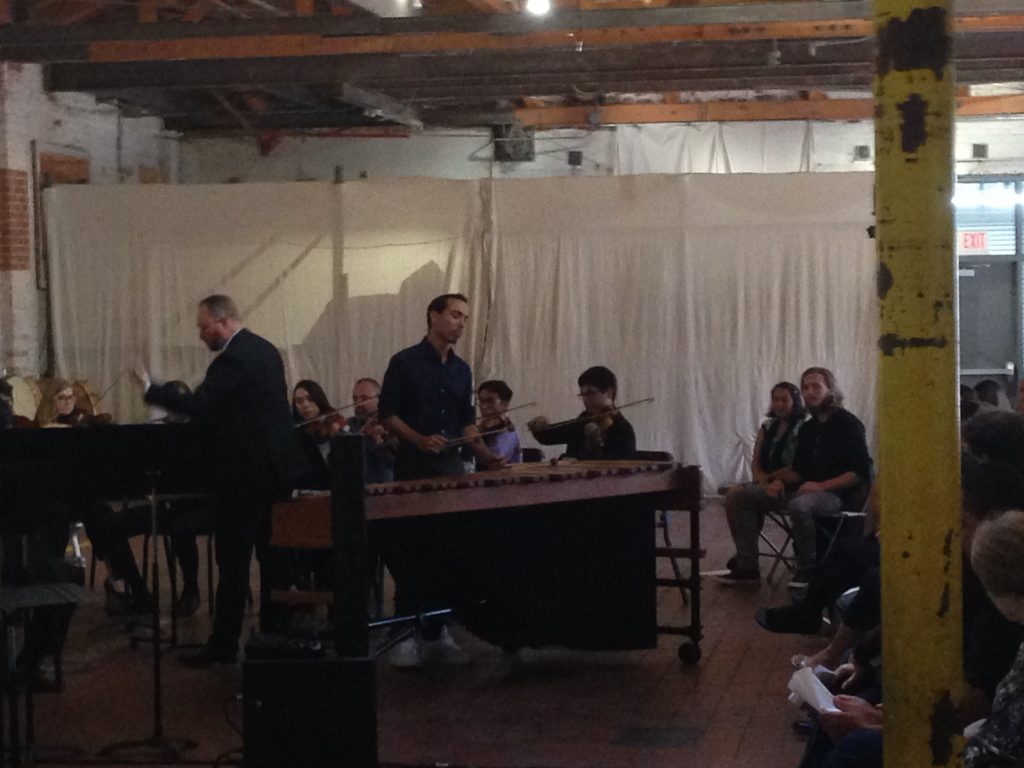San Diego State University Musicians Offer Virtuoso Contemporary Fare at Bread and Salt in Barrio Logan
Music Director Michael Gerdes took the San Diego State University Chamber Orchestra and a cache of other SDSU musicians down to Bread and Salt in Barrio Logan Sunday afternoon to perform an engaging concert of contemporary music. With its high ceiling and unfinished, bare brick walls, the chaste performance space embraces all styles of music. And new music has found a particular sonic welcome in this building that was originally built to produce commercial baked goods in quantity.

Michael Gerdes (left) and Michael Brown
Arvo Pärt’s energetic yet strangely mystical “Fratres” opened this concert. When the composer first issued this work in 1977, it had no specific instrumentation, but over the years it has been adapted from the ever practical violin and piano version to this more luxurious arrangement for solo violin, string orchestra, and percussion that the SDSU musicians presented.
Guest violinist Pei-Chun Tsai attacked the furious arpeggios that begin “Fratres,” but she had more than vigorous bowing in her quiver. She also floated slender, silvery themes above the orchestra, and her harmonics shimmered. In May, Pei-Chun, a member of the San Diego Symphony, gave an equally glowing performance of Pärt’s other minimalist icon, “Spiegel im Spiegel,” in an Art of Élan concert at the San Diego Museum of Art. Gerdes gracefully sculpted the orchestra’s subtle, sustaining textures, and the unexpected attacks from the percussion section only deepened the work’s mystery.
Pei-Chun also gave an exciting account of the prominent solo part in Joseph Martin Waters’ 2009 work “Moonlight Beach Chaconne.” For a work that lasts but 10 minutes, Waters has created a score of great density and complexity. His free-wheeling, rhapsodic violin lines interact with recorded lines manipulated by an onstage musician. Accompanying and sometimes competing with Pei-Chun’s virtuosic solo violin, Michael Brown fashioned intense, reverberant waves of sound from the marimba. To all of this, a seven-voice mixed chorus with electronic keyboard continuo added a bright, textless chorale to heighten the Chaconne’s drama. Appropriately, SDSU’s new Director of Choral Studies Arian Khaefi conducted Waters’ piece.
And for those who pay really close attention, fragments of a famous J. S. Bach theme—from his frequently encountereded Chaconne from the D Minor Solo Violin Partita, BWV 1004—weave in and out. “Moonlight Beach Chaconne” ends rather abruptly, however. Perhaps this avant-garde concerto needs another movement or two to continue to flesh out the many possibilities Waters has crafted in his richly textured opus.
Pei-Chun was at last given a well-deserved rest, and Michael Brown took center stage with his marimba to perform Emmanuel Séjourné’s 2006 Concerto for Marimba and String Orchestra. This sumptuous, unapologetically tonal score roils with voluptuous, surging themes that kept suggesting to me the lush, dramatic motion picture scores of Michel Legrand. Brown commanded the flamboyant, virtuoso marimba effusions with apparent ease, and Gerdes coaxed undulant, scintillating textures from his strings.
Séjourné has structured his concerto in the typical three-movement format, although the traditional, calmer center movement sports a dazzling descending cadenza for the soloist. The concerto’s finale provides pyrotechnics unlimited for both orchestra and soloist. I particularly appreciated the movement’s asymmetrical 5/4 ostinato over which Brown turned out a deliciously ornate cantilena.
This concert was presented by San Diego State University’s School of Music and Dance on Sunday, September 29, 2019, at Bread and Salt in San Diego’s historic Barrio Logan district.
